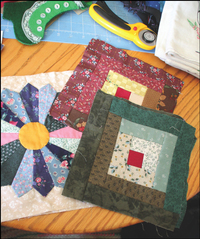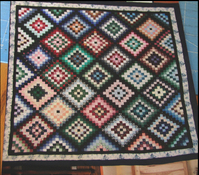If you ask Ida Borntreger or her daughters about quilts, you will be absolutely delighted by the array of hand-quilted blankets the women have to display. Members of the Amos Borntreger family at Tripp, the women have created a wide range of eye-catching colors, patterns and sizes.
“Quilting work is done in between other daily household chores,” Ida says. “We don’t just sit and work on a quilt until it’s done. But we quilt nearly every day of the week.”
Ida, who recently came from north-central Iowa when she married the widowed Amos, brought a green quilt with her that her family had sewn.
“All girls receive a quilt when they marry,” Ida says. “Amish girls are usually about 13 when they begin learning how to quilt.”
Martha Borntreger’s first quilting project was a full-sized Fiesta quilt pattern that consisted of dozens of two-inch pieces of cloth. She cut the cloth with a rotary cutter, then carefully stitched them together on one of the family’s treadle sewing machines.
“It seemed like a challenge,” Martha says now. “It was a quilt that someone had ordered.
Mom helped me get the blocks together and I finished it.”
Patterns for the quilts come from a variety of sources, including books and magazines that feature both standard and unique quilting patterns.
“The Fiesta pattern seems to be a favorite,” Rachel says. “When we lived in Wisconsin we sold many of them.”
The women’s quilting tools are what you would find on most any quilter’s table. A well-worn rotary cutter, cutting mat and plastic template are all part of their tool box.
Treadle sewing machines are common in the Amish household because they don’t require electricity. Because they do so much sewing – quilts, potholders, wall hangings and all their clothing – the Borntregers maintain about seven sewing machines all the time.
“When one of us starts working on a quilt, we try to finish it,” Ida says. “We use the same sewing machine for the quilt because if you change machines there is a difference in the stitching.”
Hand quilting the elaborate patterns that make the quilts so sought after is done using a quilting frame.
“The hand stitching is what draws people to the Amish quilts,” Martha says. “People also seem to like the variety of colors found in Amish quilts.”
Materials for the quilts come from various places. On occasion, people bring material to the family. Other pieces are purchased at mill end factories and major fabric stores.
“We don’t use any special thread,” Ida says.
“Thread colors are matched to the quilt. Before we begin the hand stitching, we use a pencil that’s similar to chalk to mark the hand stitching pattern.”
The art of quilting dates back to 1395. Historic records have long documented that Europe’s kings and members of royal families maintained quilts in their homes and received quilts as gifts.
The earliest known patchwork quilt is attributed to Britain in 1718. The earliest surviving North American (Canada) patchwork quilt is from 1726. In American pioneer history, quilting bees were spring and summer social occasions that signaled an end to long, cold winters.
Amish communities, in distancing themselves from modern conveniences, resisted making quilts until sometime in the 1870s. While Amish artisans often create quilts with specific patterns and colors for customers, those found in their own homes are made to be practical and functional.
Initially, typical Amish quilts included browns, shades of rust and black. In spite of the limited colors, intricate designs gave the quilts great eye appeal. Over a period of time, additional quilt colors were adopted.
In their “History of Amish Quilting,” Dutchcrafters note that “the popularity of Amish quilts in the broader population has resulted in a resurgence of interest in them as unique works of art. Increasingly, more and more people want their own original Amish quilt—not only for its practical value, but also for its artistic value.
Amish quilts have even been celebrated on commemorative stamps with the U.S. Postal Service and in many museums and art galleries.
Amish quilts have also been included in a selection of quilts at the National Collection in the Smithsonian National Museum of American History.
“Along with the traditional use of covering a bed, today quality quilts are often used to decorate walls or displayed as artwork. Amish-made quilted pillows, table runners and small wall hangings are also available.”
Quilts have become family heirlooms, often expressing family values and faith through their design. The fact that Amish quilts are high quality and one-of-a-kind creations gives them great appeal.
”My first wife, Viola, loved to sew,” Amos says. “My girls love to sew, too. One of the unique patterns they’ve worked with is the broken star. Single, double and triple Irish chain quilts are also very popular.”
The Borntreger women maintain a photo file of quilts they’ve made and welcome inquiries about their patterns, materials and variety of color schemes.
“Unless we have an order for a specific pattern and color, we take the material we have and put a color scheme together,” Rosa says. “We seldom make two quilts that are alike.”
Once quilt batting and backing are sewn on to the quilt, the hand stitched pattern is completed.
The process makes the quilt very functional in terms of warmth and very sturdy for everyday use.
“We can make just a quilt top and someone can finish it if they like, or we can take a quilt top someone else made and finish it with the stitching, batting and backing,” Ida says. “We make a lot of potholders and table runners, wall hangings. If it’s quilted we can make it.”
The women also take on some embroidery work.
“That takes a lot of time,” Esther says. “But there are people who like it.”
None of the women view quilt projects as a chore. It has become a routine part of their daily life.
“It’s a tradition in our families,” Amos says. “Our mothers and grandmothers quilted. It’s a craft that’s handed down from generation to generation.”




